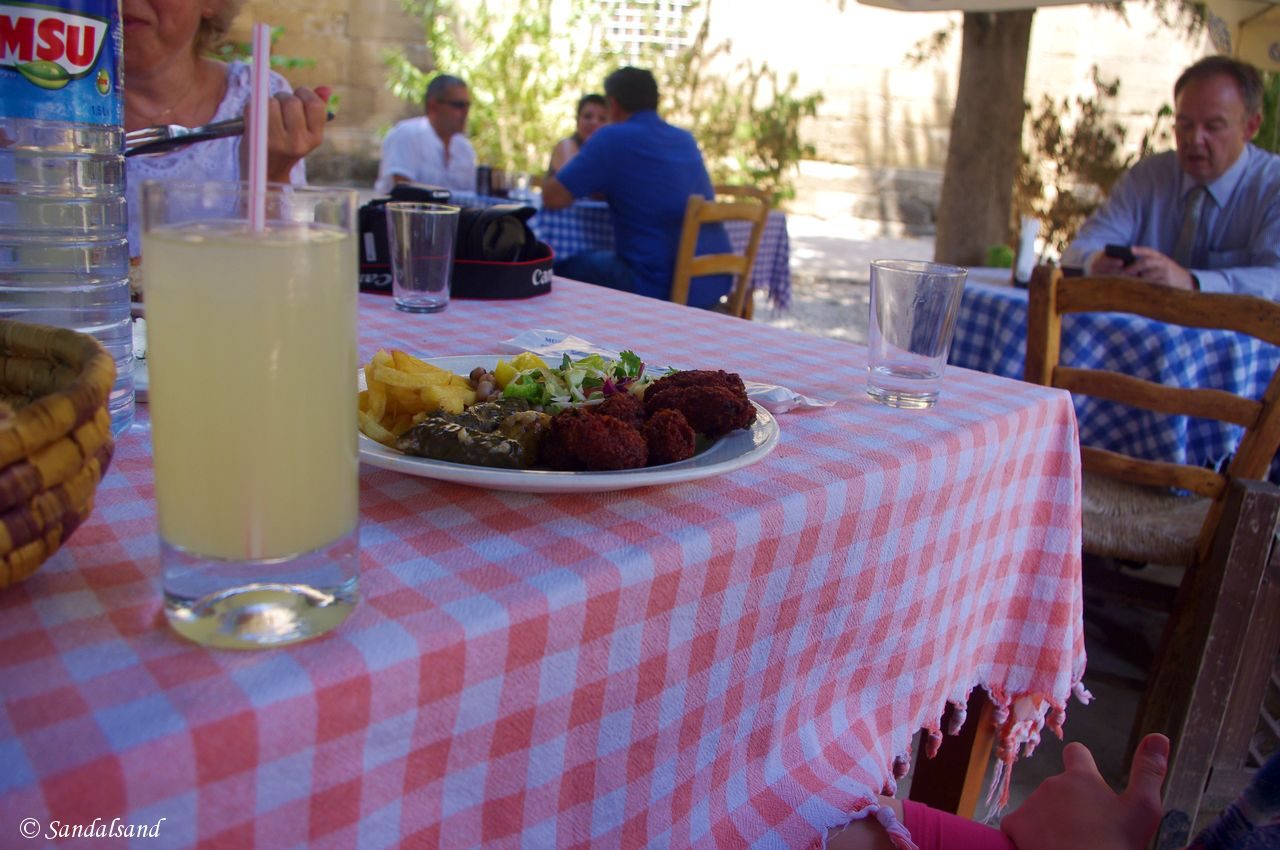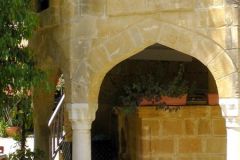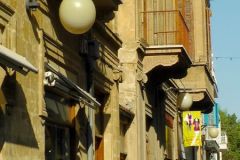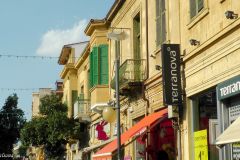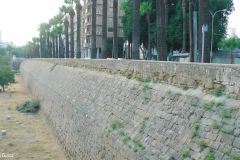On our daytrip into northern Cyprus we left Salamis on the east coast for a long drive across the flat plain into the capital of Cyprus, Nicosia. This is a divided city, bearing the unmistakable signs of war.
Driving into northern Nicosia
On the way we could clearly see a gigantic flag representing Northern Cyprus carved into the northern hills and painted in bright colours. It was also visible the other day, when we were driving south of the border. An obvious, and in my view unnecessary, provocation.
Northern Nicosia seemed like a maze of narrow streets. Our Greek Cypriot driver was clearly not familiar with this part of the city, and I had to assist him in navigating into the centre. (Some apps are nicer than others, I used OfflineMaps and the ever present GPS system on my smart phone.)
This is the fourth of four chapters from Cyprus. It was a family trip to Ayia Napa on the eastern coast, with day trips into the Troodos mountains in the middle, and across the Green Line to the Turkish side in the north.
What we saw in northern Nicosia
We did not have time for an extensive exploration of the city as we had spent the morning in Famagusta and Salamis. We found after some searching a place to park the minibus and walked off in the direction of the most important sight in northern Nicosia, the Selimiye Mosque.
Selimiye Mosque
The structure was originally the largest and oldest surviving Gothic style church of Cyprus, dating back to the early 12th century. It used to be called the Cathédrale Sainte Sophie and was converted to a mosque after the Ottoman invasion of 1570. Thus it had the same fate as the cathedral of Famagusta we had seen earlier in the day. There is also a parallel to the much more famous cathedral of the same name, the Aya Sofia, in Istanbul. The latter was also converted to a mosque but is now only a museum.
There were prayers going on so we could not enter the Selimiye Mosque. Instead we walked around the corner to the right and found a very pleasant outdoor restaurant to have lunch in. In the shade of high trees, accompanied by the sound of crickets and visual sight of cats we had a most marvellous Turkish meal. Turkish cuisine has always been among my favourites. (Let me add that we carried no Turkish lira, the currency here, but Euros work fine and so do credit cards.)
Büyük Han
We continued on the streets of Nicosia looking for the old caravanserai called Büyük Han. It is considered to be one of the finest buildings on the island and it probably is. A caravanserai is traditionally a roadside inn built by the Ottomans to supply shelter and supplies for travellers. There used to be a string of them, in particular in Turkey and along the Silk Road. (Read my story from the Silk Road.)
This one in the Turkish side of Nicosia used to be in desperate need of maintenance, according to a poster near the entrance. Now it has been restored and is full of cafes and souvenir shops. That aside, it was a pleasant two-storey squared court we entered, with a tiny mosque in the centre. This was a place to relax on a hot summer’s day.
Moving into southern Nicosia
Getting in
We criss-crossed our way back to the minibus and found the way out of the city centre. There is a crossing for pedestrians coming from or entering the southern side of Cyprus at Ledra street right here in the centre. We were driving so we had to take the long way round to the western outskirts of Nicosia.
We had our papers in order and were let into the south. The immediate impression was that of much more affluent neighbourhoods. Our driver was now back in his own virtual backyard and took us past the streets which were barricaded during the Civil War, and still is. There are only a few places open for crossings of the border. There were rusty barrels filled with concrete, and there was barbed wire all over. Just like in Famagusta’s famous Ghost Town.
Our day was coming towards an end but we still had a couple of hours. We were let off near the old fortress wall to the Old Nicosia. Once there was a wall fortified by the Venetians going round the entire city, it is now only partially visible. (By the way, the Turkish call the city Lefko?a and in Greek it is Levkosia.)
An important museum
High on the list of interests of some of the group members was a particular museum. The name? The Byzantine Museum of the Archbishop Makarios III Foundation. The Archbishop with his high hat was a popular figure on TV screens back in 1974, but he was expelled from the country. At this museum, bearing his name there are a couple of cars which once belonged to him. The reason we came here was another.
In the years after the Civil War there was an awful lot of pillaging of Greek churches (and possibly other places as well). We had the previous day visited the UNESCO World Heritage Site called “Painted churches in the Troodos Region“. All ten churches included in the Site are located in the south. There might have been candidates in the north as well, but not any more.
In the north murals, icons and very ancient mosaics disappeared in the first few years after the war. They reappeared on the international black market of art dealers. Over the years an international operation succeeded in getting some of the treasures back, including some very rare 6th century mosaics. Think of it: 6th century!
A little piece of advice: You don’t want to miss this.
Ledra street
And now finally, Ledra Street. This is what I imagine most tourists come to see, although there are plenty more museums to visit. The case is that this very long pedestrian streets is optimised for shopping, people-watching, coffee-drinking and everything else decadent. One end of the street ends at the popular crossing into the Turkish part of Nicosia.
We turned the other way, headed for the Venetian wall and our rented minibus. On the way we looked up, we looked sideways and we had a very satisfying cup of coffee and more at a streetside café.
It had been a very long day when we returned to our hotel in Ayia Napa only an hour away on the very good motorways of Cyprus.
A round-up of Cyprus
I have in four articles shared 5,700 words and 76 pictures. But there are many more impressions. For one, my private album contains 1,212 picture and video files. Secondly, our group of eight persons varied highly in age and interests but we found common denominators and ways to satisfy individual wishes. Cyprus is in short a perfect place to spend a week or two, for all. Some would say more, the real estate market is growing in the south as well as in the north.
There are plenty of sights to be seen away from the hustle and bustle of the seaside resorts. Ayia Napa was alright, but at the same time just as disappointing as I expected. I’m not the ordinary touristy type seeking sun and bath. Consequently the two day trips into the Troodos mountains and northern Cyprus came as a relief – even on a short week vacation.
I love Turkish food and could easily have spent more time in the quiet northern side. Likewise there was much more to explore along the southern coast, and walking into the villages of the mountains I felt like wanting to spend several days here. And why not mountain hikes in the shoulder seasons?
They drive on the left all over the island, a British legacy they could easily get rid of. But the road systems seemed very well developed and sign-posted. Everything in the north was written in Turkish and in Greek in the south, but for a foreigner the difference doesn’t really matter.
This was a very pleasant first visit to a beautiful island in the sun.
Read more
This article is the fourth of four from Cyprus. All articles:
(1) The easy life on the beaches of Ayia Napa
(2) A day-trip into the Troodos mountains
(3) A day-trip into Northern Cyprus

